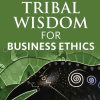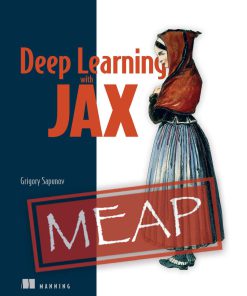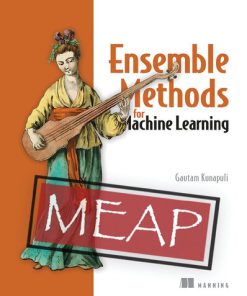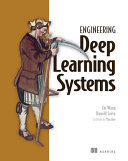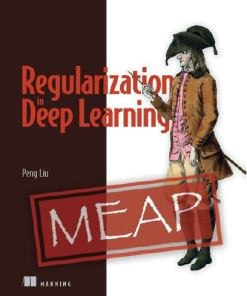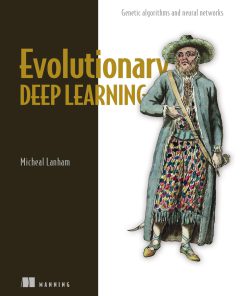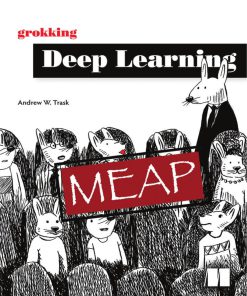Evolutionary Deep Learning MEAP Version 10 1st Edition by Micheal Lanham ISBN 1617299529 9781617299520
$50.00 Original price was: $50.00.$25.00Current price is: $25.00.
Evolutionary Deep Learning MEAP Version 10 1st Edition by Micheal Lanham – Ebook PDF Instant Download/Delivery: 1617299529 ,9781617299520
Full download Evolutionary Deep Learning MEAP Version 10 1st Edition after payment
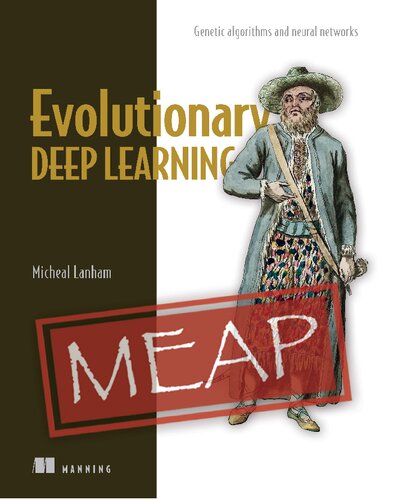
Product details:
ISBN 10: 1617299529
ISBN 13: 9781617299520
Author: Micheal Lanham
Discover one-of-a-kind AI strategies never before seen outside of academic papers! Learn how the principles of evolutionary computation overcome deep learning’s common pitfalls and deliver adaptable model upgrades without constant manual adjustment. Evolutionary Deep Learning is a guide to improving your deep learning models with AutoML enhancements based on the principles of biological evolution. This exciting new approach utilizes lesser- known AI approaches to boost performance without hours of data annotation or model hyperparameter tuning. Google Colab notebooks make it easy to experiment and play around with each exciting example. By the time you’ve finished reading Evolutionary Deep Learning, you’ll be ready to build deep learning models as self-sufficient systems you can efficiently adapt to changing requirements
Evolutionary Deep Learning MEAP Version 10 1st Edition Table of contents:
Chapter 1: Introduction to Evolutionary Deep Learning
1.1 What is Evolutionary Deep Learning?
1.1.1 An Introduction to Evolutionary Computation
1.2 The Need for Deep Learning Optimization
1.2.1 Optimizing the Network Architecture
1.3 Automating Optimization with Automated Machine Learning
1.3.1 What is Automated Machine Learning, AutoML?
1.4 Strategies for Applying Evolutionary Deep Learning
1.4.1 Model Selection – Weight Search
1.4.2 Model Architecture – Architecture Optimization
1.4.3 Hyperparameter Tuning/Optimization
1.4.4 Validation and Loss Function Optimization
1.4.5 Neuroevolution of augmenting topologies (NEAT)
1.4.6 Goals
1.5 Summary
Chapter 2: An Introduction to Evolutionary Computation
2.1 Conway’s Game of Life on Google Collaboratory
2.2 Simulating Life with Python
2.2.1 Learning Exercises
2.3 Life Simulation as Optimization
2.3.1 Learning Exercises
2.4 Adding Evolution to the Life Sim
2.4.1 Simulating Evolution
2.4.2 Learning Exercises
2.4.3 Some Background on Darwin and Evolution
2.5 Genetic Algorithms in Python
2.5.1 Constructing the Population
2.5.2 Evaluating Fitness
2.5.3 Selecting for Reproduction (Crossover)
2.5.4 Applying Crossover – Reproduction
2.5.5 Applying Mutation and Variation
2.5.6 Putting it all Together
2.5.7 Understanding GA Hyperparameters
2.5.8 Learning Exercises
2.6 Summary
Chapter 3: An Introduction to Genetic Algorithms with DEAP
3.1 Genetic Algorithms in DEAP
3.1.1 One Max with DEAP
3.1.2 Learning Exercises
3.2 Solving the Queens Gambit
3.2.1 Learning Exercises
3.3 Helping a Traveling Salesman
3.3.1 Building the TSP Solver
3.3.2 Learning Exercises
3.4 Selecting Genetic Operators for Improved Evolution
3.4.1 Learning Exercises
3.5 Painting with the EvoLisa
3.5.1 Learning Exercises
3.6 Summary
Chapter 4: More Evolutionary Computation with DEAP
4.1 Genetic Programming with DEAP
4.1.1 Solving Regression with Genetic Programming
4.1.2 Learning Exercises
4.2 Particle Swarm Optimization with DEAP
4.2.1 Solving Equations with PSO
4.2.2 Learning Exercises
4.3 Co-evolving Solutions with DEAP
4.3.1 Co-evolving Genetic Programming with Genetic Algorithms
4.4 Evolutionary Strategies with DEAP
4.4.1 Applying Evolutionary Strategies to Function Approximation
4.4.2 Revisiting the EvoLisa
4.4.3 Learning Exercises
4.5 Differential Evolution with DEAP
4.5.1 Approximating Complex and Discontinuous Functions with DE
4.5.2 Learning Exercises
4.6 Summary
Chapter 5: Automating Hyperparameter Optimization
5.1 Option Selection and Hyperparameter Tuning
5.1.1 Tuning Hyperparameter Strategies
5.1.2 Selecting Model Options
5.2 Automating HPO with Random Search
5.2.1 Applying Random Search to HPO
5.3 Grid Search and HPO
5.3.1 Using Grid Search for Automatic HPO
5.4 Evolutionary Computation for HPO
5.4.1 Particle Swarm Optimization for HPO
5.4.2 Adding EC and DEAP to Automatic HPO
5.5 Genetic Algorithms and Evolutionary Strategies for HPO
5.5.1 Applying Evolutionary Strategies to HPO
5.5.2 Expanding Dimensions with Principal Component Analysis
5.6 Differential Evolution for HPO
5.6.1 Differential Search for Evolving HPO
5.7 Summary
Chapter 6: Neuroevolution Optimization
6.1 Multi-layered Perceptron in NumPy
6.1.1 Learning Exercises
6.2 Genetic Algorithms as Deep Learning Optimizers
6.2.1 Learning Exercises
6.3 Other Evolutionary Methods for Neuro-optimization
6.3.1 Learning Exercises
6.4 Applying Neuroevolution Optimization to Keras
6.4.1 Learning Exercises
6.5 Understanding the Limits of Evolutionary Optimization
6.5.1 Learning Exercises
6.6 Summary
Chapter 7: Evolutionary Convolutional Neural Networks
7.1 A Review of Convolutional Neural Networks in Keras
7.1.1 Understanding CNN Layer Problems
7.1.2 Learning Exercises
7.2 Encoding a Network Architecture in Genes
7.2.1 Learning Exercises
7.3 Creating the Mating Crossover Operation
7.4 Developing a Custom Mutation Operator
7.5 Evolving Convolutional Network Architecture
7.5.1 Learning Exercises
7.6 Summary
Chapter 8: Evolving Autoencoders
8.1 The Convolution Autoencoder
8.1.1 An Introduction to Autoencoders
8.1.2 Building a Convolutional Autoencoder
8.1.3 Learning Exercises
8.1.4 Generalizing a Convolutional Autoencoder
8.1.5 Improving the Autoencoder
8.2 Evolutionary Autoencoder Optimization
8.2.1 Building the AE Gene Sequence
8.2.2 Learning Exercises
8.3 Mating and Mutating the Autoencoder Gene Sequence
8.4 Evolving an Autoencoder
8.4.1 Learning Exercises
8.5 Building Variational Autoencoders
8.5.1 Variational Autoencoders a Review
8.5.2 Implementing a VAE
8.5.3 Learning Exercises
8.6 Summary
Chapter 9: Generative Deep Learning and Evolution
9.1 Generative Adversarial Networks
9.1.1 Introduction or Review to GANs
9.1.2 Building a Convolutional GAN in Keras
9.1.3 Learning Exercises
9.2 Understanding the Difficulty of Training a GAN
9.2.1 The GAN Optimization Problem
9.2.2 Observing Vanishing Gradients
9.2.3 Observing Mode Collapse in GANs
9.2.4 Observing Convergence Failures in GANs
9.2.5 Learning Exercises
9.3 Fixing GAN Problems with Wasserstein Loss
9.3.1 Understanding Wasserstein Loss
9.3.2 Improving the DCGAN with Wasserstein Loss
9.4 Encoding the Wasserstein DCGAN for Evolution
9.4.1 Learning Exercises
9.5 Optimizing the DCGAN with Genetic Algorithms
9.5.1 Learning Exercises
9.6 Summary
Chapter 10: NEAT: NeuroEvolution of Augmenting Topologies
10.1 Exploring NEAT with NEAT-Python
10.1.1 Learning Exercises
10.2 Visualizing an Evolved NEAT Network
10.3 Exercising the Capabilities of NEAT
10.3.1 Learning Exercises
10.4 Exercising NEAT to Classify Images
10.4.1 Learning Exercises
10.5 Uncovering the Role of Speciation in Evolving Topologies
10.5.1 Tuning NEAT Speciation
10.5.2 Learning Exercises
10.6 Summary
Chapter 11: Evolutionary Learning with NEAT
11.1 Introduction to Reinforcement Learning
11.1.1 Q Learning Agent on the Frozen Lake
11.1.2 Learning Exercises
11.2 Exploring Complex Problems from the OpenAI Gym
11.2.1 Learning Exercises
11.3 Solving Reinforcement Learning Problems with NEAT
11.3.1 Learning Exercises
11.4 Solving Gyms Lunar Lander with NEAT Agents
11.4.1 Learning Exercises
11.5 Solving Gyms Lunar Lander with DQN
11.6 Summary
People also search for Evolutionary Deep Learning MEAP Version 10 1st Edition:
deep learning evolutionary algorithms
evolutionary neural automl for deep learning
deep evolutionary learning for molecular design
evolutionary neural networks for deep learning a review
deep learning is best described as
Tags: Micheal Lanham, Evolutionary Deep Learning, Version 10, MEAP
You may also like…
Computers - Algorithms and Data Structures
Computers - Artificial Intelligence (AI)
Ensemble Methods for Machine Learning – MEAP Version 6 Gautam Kunapuli
Computers - Artificial Intelligence (AI)
Computers - Artificial Intelligence (AI)
Uncategorized
Computers - Artificial Intelligence (AI)
Regularization in Deep Learning (Manning Early Access Program Version 3) MEAP Peng Liu
Uncategorized
Uncategorized
Computers - Artificial Intelligence (AI)

